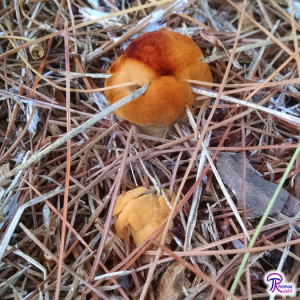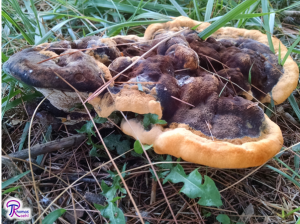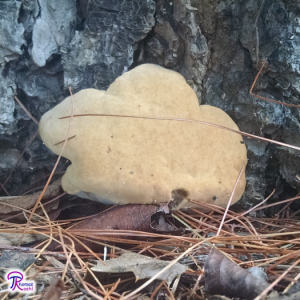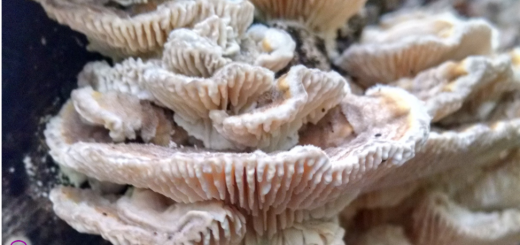#201: Phaeolus schweinitzii, The Dyer’s Polypore

Phaeolus schweinitzii is recognized by its growth on the ground, and fuzzy brown pileus with a yellow/orange margin.
Phaeolus schweinitzii is a common polypore that parasitizes conifer trees. Around the bases of its victims, it produces medium-sized to large mushrooms in overlapping rosettes resembling haphazardly stacked dinner plates. The mushrooms are brown and fuzzy in the center and yellow around the edges. P. schweinitzii attacks the roots and lower trunk of older trees, making them more likely to fall in a storm. Although it routinely causes headaches for foresters and homeowners alike, people in the mushroom dyeing community covet this fungus. It dyes wool various shades from bright yellow to dark green, which earned it the common name “the Dyer’s Polypore.” Other common names used for P. schweinitzii are “Velvet-Top Fungus” and “Dyer’s Mazegill” (British).1,2
Description
Mushrooms of P. schweinitzii usually grow on the ground, so they usually have a more or less circular pileus and a central stipe. As the mushroom grows, it usually develops lobes and multiple caps that stack on top of one another. The caps grow 4-30cm across, although multiple mushrooms fruiting close together often fuse together and form large clusters 60cm across or larger. Each mushroom attaches to the ground with a short thick stipe that grows 1-6cm tall and 1-5cm thick. The mushroom follows a pattern of indeterminate growth, so it usually engulfs sticks, pine needles, and other debris as it grows.2–5
When the mushroom first emerges, the entire surface is covered in velvety yellow tissue that stains brown immediately when touched. This is the mushroom’s actively growing surface. As a testament to this fact, the stains on the tissue don’t last long; within an hour or two bruised areas become bright yellow again as new growth covers up the injury (amazingly, this can happen even after a mushroom has been picked).
As the mushroom matures, the pileus flattens out and becomes brown and fuzzy over the center while the actively growing surface remains a swollen yellow velvety ring along the margin. The pileus often features alternating bands of color and texture. P. schweinitzii is highly variable in color; its margin can be anywhere from nearly white to bright yellow and its darker center can range from olive-brown to dark brown. The center of the pileus gradually becomes less fuzzy with age, which can make old specimens difficult to identify.2–5
The underside of the mushroom is covered by a greenish-yellow pore surface. Pores begin to form just behind the actively-growing rim and extend all the way down the stipe. The pores are originally yellow like the margin but soon become a paler greenish-yellow and eventually turn olive. In very old mushrooms, the pores develop a brownish color. Like the actively growing areas, the pore surface quickly bruises brown when injured. The pores are initially angular but some will fuse with other nearby pores to create large convoluted pores. This layer produces spores that appear whitish to pale yellowish in a spore print.2–5
Inside the mushroom, the flesh is yellowish brown, becomes reddish-brown with age, and is often faintly lined. The mushroom is initially soft but soon becomes leathery.2,3,5 Fresh mushrooms are easy to cut and readily rip apart on the edges. The base is often difficult to cut, partially because it has the highest concentration of engulfed debris. When dried, the flesh is very crumbly and easily breaks apart.
Ecology
P. schweinitzii is parasitic on the wood of living conifers and continues to decompose its hosts after they die. In the western half of North America, its preferred host is Douglas-fir, while in eastern North America it is usually found on Eastern White Pine and in southern North America it favors Loblolly Pine.3 In Europe, it primarily attacks pines and spruces.2 The fungus is a “butt rot,” primarily attacking the heartwood of the roots and lower trunk (no more than the bottom 8ft or so). It causes a brown rot and stunts root growth, making its host more susceptible to falling down in high wind.1,6 Because it attacks the base of the tree, the mushrooms usually appear on the ground near their host. Sometimes they do grow directly on wood, but that is unusual. The mushrooms fruit in the summer and fall, but may pop up at other times of the year, depending on the climate.2,4

P. schweinitzii usually grows from the ground and can display a variety of colors, from light yellow to orangish.
P. schweinitzii usually infects young trees through the root tips and slowly eats away at the tree’s base as the tree continues to grow. However, it can infect older trees, especially if they have been damaged by mechanical means or by insects or other fungi. The pathogen’s effects are not apparent until the tree is old; the fungus does not cause any visible wounds, so fruiting bodies are the only direct sign that the tree is infected. By the time it starts producing mushrooms, the fungus has already done substantial damage to the wood at the base of the tree. On top of that, P. schweinitzii infection often encourages other insects and fungi to attack the tree, weakening it further. This causes economically significant losses in stands of lumber trees because the most valuable wood is near the tree’s base.1,6
Because the fungus is common and native across much of the northern hemisphere, there is not much foresters can do to prevent infection. The best advice is to ensure the forest is healthy by thinning stands appropriately and avoiding activities that damage the lower portions of trees. Stands of susceptible trees older than 100 to 120 years should be planted with something else to deprive the disease of hosts in that area. Stands can also be planted with resistant trees such as Western Larch to avoid the disease altogether.6
Similar Species
There are quite a few polypores that could be mistaken for P. schweinitzii. The most likely source of confusion is Inonotus tomentosus. It is also a fuzzy brown and yellow polypore that can form rosettes at the bases of conifers. I. tomentosus can be distinguished by its smaller and thinner mushrooms and the lack of greenish tones on its pore surface.4
Inonotus hispidus is also similar, but fruits directly from the wood of hardwood trees. The position on the diseased tree is enough to separate I. hispidus (on the trunk) and P. schweinitzii (on the ground) in all but the most unusual cases.7
Phellinus gilvus has a brown center and yellow margin like P. schweinitzii, but P. gilvus fruits directly from the wood of hardwoods. Once, I found this growing from the ground but correctly identified it because there were no conifers around, its center was darker and less hairy than P. schweinitzii, and its margin was droopier than P. schweinitzii (the margin was slightly lower than its point of attachment, whereas the margin of P. schweinitzii is always significantly higher than its base).8
Another species that can give you problems is Laetiporus persicinus (FFF#191), which tends to key out in field guides as P. schweinitzii. Indeed, the two mushrooms have similar patterns in growth, texture, bruising, and color arrangement. However, L. persicinus does not have any yellow colors and fruits beneath hardwoods, so they are easy to separate.

P. schweinitzii is a notorious pathogen of conifer trees. However, it is also highly valued by people who use it to dye wool.
Uses
P. schweinitzii is way too tough to consider eating (and it may be poisonous),2,5 but it does have another use: this mushroom is one of the best to use for dyeing wool (see FFF#159).1,9 The Dyer’s Polypore produces strong colors ranging from golden-yellow to forest green, depending on the age of the mushroom and what mordant was used.1,9 Fresh fruiting bodies with a large yellow rim produce the best colors. With alum as a mordant, these dye wool a bright golden-yellow to yellow-orange. If iron salts are used instead, the color becomes a deep forest green. Using a copper mordant results in a chocolate-brown color. The mushroom will also dye wool yellow without a mordant, but using a mordant makes the colors more durable.9
Taxonomy
The Dyer’s Polypore is placed in the order Polyporales, along with most other polypores. P. schweinitzii is the type species for Phaeolus, so it will remain part of Phaeolus even if other species are removed because of DNA evidence. Phaeolus translates to “somewhat dark” or “somewhat obscure.” This refers to the darkish colors over the center of the mushroom’s pileus.2
| Kingdom | Fungi |
| Division (Phylum) | Basidiomycota |
| Subdivision (Subphylum) | Agaricomycotina |
| Class | Agaricomycetes |
| Order | Polyporales |
| Family | Fomitopsidaceae |
| Genus | Phaeolus |
| Species | Phaeolus schweinitzii (Fr.) Pat.10 |
See Further:
http://www.mushroomexpert.com/phaeolus_schweinitzii.html
http://botit.botany.wisc.edu/toms_fungi/nov2007.html
http://www.mykoweb.com/CAF/species/Phaeolus_schweinitzii.html
Citations
- Volk, T. J., Hanmer, D. & University of North Carolina Pembroke Fall 2007 Mycology Class. Phaeolus schweinitzii, the dye polypore or velvet-top fungus. (2007). Available at: http://botit.botany.wisc.edu/toms_fungi/nov2007.html. (Accessed: 28th September 2017)
- O’Reilly, P. Phaeolus schweinitzii (Fr.) Pat. – Dyer’s Mazegill. First Nature Available at: http://www.first-nature.com/fungi/phaeolus-schweinitzii.php. (Accessed: 28th September 2017)
- Kuo, M. Phaeolus schweinitzii. MushroomExpert.Com (2016). Available at: http://www.mushroomexpert.com/phaeolus_schweinitzii.html. (Accessed: 28th September 2017)
- Emberger, G. Phaeolus schweinitzii. Fungi Growing on Wood (2008). Available at: http://www.messiah.edu/Oakes/fungi_on_wood/poroid%20fungi/species%20pages/Phaeolus%20schweinitzii.htm. (Accessed: 28th September 2017)
- Wood, M. & Stevens, F. California Fungi—Phaeolus schweinitzii. MykoWeb Available at: http://www.mykoweb.com/CAF/species/Phaeolus_schweinitzii.html. (Accessed: 28th September 2017)
- Hoffman, J. T. Management Guide for Schweinitzii Root and Butt Rot. (2004).
- O’Reilly, P. Inonotus hispidus (Bull.) P. Karst. – Shaggy Bracket. First Nature Available at: http://www.first-nature.com/fungi/inonotus-hispidus.php. (Accessed: 28th September 2017)
- Kuo, M. Phellinus gilvus. MushroomExpert.Com (2007). Available at: http://www.mushroomexpert.com/phellinus_gilvus.html. (Accessed: 28th September 2017)
- Hopkins, S. A Short Selection of the Best Mushrooms for Color. North American Mycological Association (2015). Available at: https://www.namyco.org/selection_of_mushrooms_for_color.php. (Accessed: 28th September 2017)
- Phaeolus schweinitzii. Mycobank Available at: http://www.mycobank.org/BioloMICS.aspx?TableKey=14682616000000067&Rec=72849&Fields=All. (Accessed: 28th September 2017)


![#027: Mushroom Morphology: Gilled Mushrooms (“Agarics”) [Archived]](https://www.fungusfactfriday.com/wp-content/themes/hueman/assets/front/img/thumb-medium-empty.png)






![#011: Characteristics of Kingdom Fungi [Archived]](https://www.fungusfactfriday.com/wp-content/themes/hueman/assets/front/img/thumb-small-empty.png)

1 Response
[…] quercinus from similar species. The most similar yellow polypore is probably Phaeolus schweinitzii (FFF#201), which is a polypore that has a fuzzy yellow pileus and stains brown when touched. However, P. […]